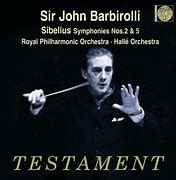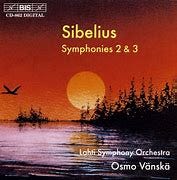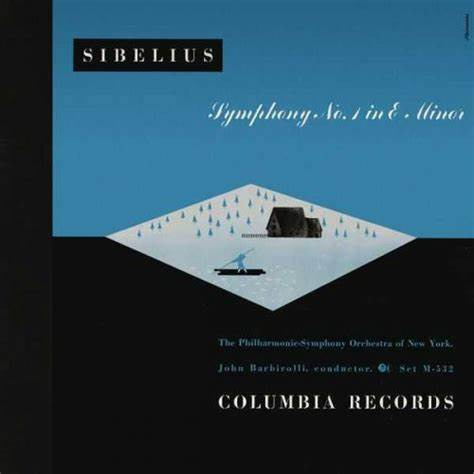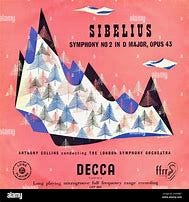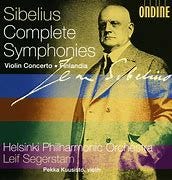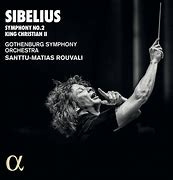Building a Collection #43
Symphony no. 2 in D major, Op. 43
Jean Sibelius
_____________
“My second symphony is a confession of the soul.”
Jean Sibelius
Welcome back to Building a Classical Music Collection! In our Building a Collection series, we have arrived at #43. In this spot is Symphony no. 2 in D major, Op. 43 by Finnish composer Jean Sibelius. A personal favorite of mine, the symphony is likely the most well-known work by Sibelius.
Jean Sibelius
Jean Sibelius (b.1865 – d.1957) was a Finnish composer of the late Romantic and early Modern periods of classical music. Although he was born into a Swedish speaking family (Finland was ruled by Sweden for centuries), Sibelius eventually learned to speak Finnish and later became immersed in Finnish culture. He is regarded as the greatest Finnish composer in history, and his music is especially noted for its nationalistic themes and for helping Finland develop a national identity during a time when the country was fighting for independence from Russia. Sibelius is also credited with the further development of the symphony and the tone poem as musical forms.
As a young man entering college, Sibelius was drawn more and more to music. While he began as a violinist, he soon came to realize composition was his true calling. In 1889, he traveled to Berlin to study composition, and it was there he was exposed to the music of Richard Strauss which was very influential to him. Eventually, he made his way back to Finland to teach music and in 1893 his first substantial work Kullervo was premiered to significant acclaim. Kullervo is a symphonic poem for soloists, male chorus and orchestra, and is based on the Finnish folk epic Kalevala. It was so successful that Sibelius was soon dubbed the leading composer in Finland. In 1897 the Finnish Senate decided to pay Sibelius a salary for a time, which was eventually extended to a lifetime pension. Today there is a wonderful museum dedicated to the composer in the heart of Helsinki which I was fortunate enough to visit several years ago.
Sibelius’ Symphony no. 1 in 1899 was relatively successful but was then followed in 1900 by the enormously successful and enduring work Finlandia. Finlandia is a tone poem of nationalistic importance, at least in part due to the political climate at the time when it was created. Because Finland was under Russian censorship at the time, there was the desire to break free from Russia’s czarist grip. As part of the overall movement toward a free press and freedom of expression, Sibelius composed music for a fund-raising event rallying support for a free press. It was titled Music for Press Ceremony, but the score ends with “Finland Awakens”, which would eventually be called Finlandia. Since then, Finlandia has virtually become Finland’s national anthem.
Sibelius loved nature, and his music evokes stark landscapes, cold winter scenes, and an almost other-worldly atmosphere. Sibelius developed his own unique sound that can be heard especially in works such as En saga, The Swan of Tuonela, Valse Triste, Symphonies 1, 2, 5, and 7, and his Violin Concerto. Sibelius met the composer Gustav Mahler in 1907, and they discovered they had some things in common. Generally speaking, as both of them matured as artists and developed their styles during the early 20th century, critics were brutal in their assessment of anything that strayed from the traditional path. Since both men were pioneers in their own ways, it took courage to remain true to their own artistry. It was Sibelius’ goal to write music that was distinctively “Finnish”, and I think we can agree he was able to achieve that goal.
Sibelius achieved great fame in his lifetime, but also went through difficult periods. He was a heavy drinker and smoker for much of his life, and this led to marriage problems. Eventually he gave up those vices and lived a relatively peaceful life in his later years. During the last 30 years of his life, Sibelius composed very little new music, but continued to make revisions of his earlier works. He made frequent trips to England, where his music was widely embraced by audiences.
Symphony no. 2
In June 1900, a mysterious benefactor wrote to Sibelius that he and his family were being sponsored to travel to Italy all expenses paid to allow Sibelius to compose in a place where he would learn about harmony, proportion, and Italian “cantabile” style (“singable”). The Sibelius family moved to Rapallo, Italy (near Genoa) where the composer would subsequently begin writing what would become his Symphony no. 2.
Sibelius finished his Symphony no. 2 in 1902. Commenting on his symphony, Sibelius remarked, “My second symphony is a confession of the soul.” After the premiere of the revised version in 1903, one critic said the symphony “exceeded even the highest expectations”. The reception the symphony gained in Helsinki and across Finland was rapturous.
Today, Sibelius’ Symphony no. 2 remains his most popular symphony. There is some brilliant orchestration, and you do hear some of the influence of his time in Italy. The symphony is also a continuation of the Romantic tradition with big climaxes and an emotional undercurrent all the way along. It is Sibelius’ longest symphony at about 45 minutes. The movements are rather traditional for a symphony:
I.Allegretto
II. Tempo andante, ma rubato
III. Vivacissimo
IV. Finale. Allegro moderato
The symphony and especially the stately finale became associated by some with the struggle for Finland’s independence, similar to his earlier tone poem Finlandia. It is easy to see why this happened, as you can hear the tension in the furious strings especially in the third movement which gives way to the grand main theme of the finale complete with glowing strings, trumpet and brass fanfares, and some fantastic woodwind writing. One may interpret the triumphant hymn at the close to be almost a song of unity for the Finnish people.
In reality, it is unclear whether Sibelius intended the work to carry this message. There is some indication Sibelius denied any sort of programmatic meaning to the symphony, and in his diary from his time in Italy in 1901 he claims to have used other literary sources as his inspiration. In any case, Sibelius may have been happy for the Finnish people to see the symphony as a nationalist piece. Most critics received the symphony warmly, although Virgil Thomson in the New York Herald Tribune thought the symphony, “vulgar, self-indulgent, and provincial beyond all description”. Needless to say, Thomson’s opinion has not endured.
The genius behind the symphony seems to lie in Sibelius’ use of just a few short motifs that he introduces at the beginning, and that recur throughout the work. In fact, it develops as a sort of mosaic with similar bits reappearing again and again, but in different guise. The entire picture is not put together completely until the end of each movement. The second movement is a cry of the heart in the face of persecution if you will and has a melancholy feeling. The third movement is a frenetic scherzo, moving furiously through the strings and brass. But it is interrupted twice by an almost calming, pastoral interlude that seems to hint at the coming positive feelings. The finale is positively bursting with light and victory, a confident and happy ending to the journey.
Essential Recordings
Sibelius found a huge following in England, and especially with several of the most well-known conductors such as Sir Thomas Beecham, Sir Colin Davis, and Sir John Barbirolli.
The first essential recording is from Sir John Barbirolli leading the Royal Philharmonic Orchestra in a 1962 performance set down for Reader’s Digest by RCA (recorded at Walthamstow Town Hall in London), later remastered by the Chesky label, and now in this reissue by the Testament label. Fair warning, it can be difficult to find this recording on music streaming services. I did locate it on Spotify as the four movements listed as separate songs under “Reader’s Digest”.
This particular recording of Sibelius’ Symphony no. 2 is something special. Barbirolli studied playing the cello as a youth. He was something of a sensation as a cello soloist, making his solo debut in London at the age of 17. He notably joined the British Army during World War I, but after the war continued with his musical career, playing in several orchestras and performing as a soloist. In 1927, he scored a great success with the London Symphony Orchestra while substituting for an indisposed Sir Thomas Beecham, and pretty much from that time on he focused on conducting. He had stints as a conductor for the Scottish Orchestra, the Leeds Symphony Orchestra, and the New York Philharmonic among others. But he is perhaps best known for the long and productive time he spent with the Hallé Orchestra in Manchester, England. He retired in 1968 with the title “Conductor Laureate for Life”.
Barbirolli clearly loved Sibelius’ Symphony no. 2, as he recorded it at least four times. What makes this one so memorable is a combination of spontaneity, a keen sense of lyricism, plenty of power when needed, and a natural feeling for the building of tension and drama. The sound produced is also very good for its time, and you feel as though you are listening to a live performance. Barbirolli was never one for cheap thrills or over-the-top bombast. He tended to be more understated and analytical in his style. But he and the Royal Philharmonic catch fire in this recording. The entire recording was completed in just two days.
A few examples: listen to the pulsing strings, double basses, and brass at the beginning of the third movement Vivacissimo. The playing is vivid, exciting, and right on point. After the lyrical interlude, played with great tenderness and yearning, you hear the very fast brass fanfare snapping us back to scherzo. You can feel the music building and receding throughout the movement, and then building at the end toward the grandiose introduction of the Finale. The final movement is glorious, played with passion with great attention to detail and dynamics. The woodwinds are caught wonderfully, the strings sing out in full, and the bass instruments for once are given equal weight. The quieter passages and the climaxes both have been deeply considered and are held sacred. The words that I associate with this performance are heartfelt, gripping, electric, and brilliant. This recording cemented Barbirolli as a Sibelius expert. Not to be missed in my view.
The second essential recording is by Finnish conductor Osmo Vänskä and the Lahti Symphony Orchestra (Lahti, Finland) on the BIS label, a recording made in 1996 as part of a critically acclaimed complete Sibelius cycle. This is a first-class performance sparkling with vitality and heart. Vänskä breathes new life into this classic warhorse by using marginally quicker speeds and characterful phrasing that just feels right. The Lahti band sounds just as polished as larger, more internationally known orchestras, and the sound from BIS is outstandingly clear and realistic. I don’t want to overstate how much difference a Finnish conductor and orchestra can make with this music, but I feel like they really do in this case. This is a completely idiomatic reading, with many beautiful touches and interesting qualities. Vänskä builds the intensity so well in each movement, and there is a spontaneous quality to the playing which is infectious. Vänskä would go on to record all the symphonies again later in Minnesota, though not quite as successfully as this earlier effort. If you want this symphony in modern sound, you can look no further.
Recommended Recordings
There are many other excellent recordings of this most famous Sibelius symphony, but the ones below stand out. Listed in chronological order by recording date:
The historical recording of Symphony no. 2 from 1940 at Carnegie Hall where Barbirolli leads the New York Philharmonic on Columbia Records. Barbirolli was the music director of the NYPO from 1937-1942, and whilex his tenure there was typically viewed as a relative failure compared to his predecessor Toscanini, this recording shows precisely why Barbirolli was great in his own way. His flexibility in phrasing, his innate sense of the dynamic structure, and his deep feeling for this symphony are evident from the outset. I find there to be an extra measure of drive and freshness here that his 1966 Halle account on EMI/Warner is missing (the 1962 RPO version above is another matter). Tempos here are marginally quicker, which I like. You must understand this is a recording from 1940, so patience is required with the sound. However, I find the sound remarkably good for its age. There is some shrillness in spots, but it’s a small price to pay for such a great performance in my opinion.
British composer and conductor Anthony Collins was actually a violist and manager of the London Symphony Orchestra before moving to California to pursue a career as a film composer. But Decca tracked him down to conduct the LSO in what would be the first complete set of the Sibelius symphonies. The Second was recorded in 1953 in Kingsway Hall in London with what Decca called their "ffrr" (full frequency range recording) technique. Not quite stereo, but certainly sounding terrific for the age. On paper Collins was an odd choice, and using a British orchestra at the time was perhaps a risk. But it paid off, with Collins leading a performance of distinction, power, and character. This is inspired music-making, the sound carries you along, and the interpretation is captivating. The third and fourth movements in particular are exciting.
Hungarian American conductor Eugene Ormandy was one of the finest Sibelius interpreters ever, and he recorded the Second several times with The Philadelphia Orchestra, the orchestra he led for an incredible 44 years. By some margin his finest recording is the one he made in 1957 for Columbia (now Sony), in the same year of Sibelius’ death. Recorded at the Broadwood Hotel in Philadelphia, this account is simply beautifully played with the gorgeous strings, woodwinds, and brass the Philadelphia orchestra became known for through all their records. But Ormandy also brings a spark to the performance, and the actual playing is superior to virtually any other recording of this symphony. The sound is also excellent early stereo. What Ormandy gives up in terms of dramatic edge or bite (think Szell or Bernstein), he gains in lyricism and effective phrasing. Don’t get me wrong, there is plenty of excitement here too. I believe this is one of Ormandy’s finest recordings.
Speaking of George Szell, his 1964 recording with the Concertgebouw Orchestra, Amsterdam for Decca is among his finest recordings. Szell may never be described as a “spontaneous” conductor, but if what you want is a disciplined ensemble along with playing of verve and excitement, this one's for you. Szell is gifted with the tremendous Amsterdam orchestra, along with wonderfully warm and detailed sound from Decca (something that he didn’t always have in Cleveland). As usual, Szell’s decisions seem just right, and there is plenty of sizzle in the third and fourth movements. I have always found Szell at his best with late classical and early romantic works, so this symphony was not necessarily in his “sweet spot”. But what I like is he brings a leaner and agile quality to the performance, refusing to wallow in the romantic gestures in the score. It is more direct if you will, and it pays off well. The Finale is stirring and powerful.
Iconic American conductor Leonard Bernstein’s first recording of the Second from 1966 with the New York Philharmonic on Columbia (now Sony) finds Bernstein pushing things forward assertively which leads to an exciting and dramatic reading. Bernstein was generally very successful with Sibelius, and this is one of his best. The sound is up close and sounds freshly minted in the most recent remasterings. I would call this an incendiary and emotional reading, less refined than Ormandy but never boring. Bernstein and the New Yorkers bring a nobility and purpose to the symphony, and yet Bernstein also avoids becoming too pompous or indulgent (his later recording with the Vienna Philharmonic goes to excess in my opinion and is less exciting). The Finale has rarely been done this well. Highly recommended.
Another legendary Sibelius interpreter was Finnish conductor Paavo Berglund, and he recorded the Second several times. The finest of these is his 1976 EMI/Warner recording with the Bournemouth Symphony Orchestra. Berglund elicits playing of intensity and commitment, and the recorded sound is superb…warm, spacious, and detailed. Berglund’s approach may be termed “cool”, as in perhaps not as passionate as others. But this is not a criticism at all, as this approach allows for other aspects of the music to emerge. Berglund is more flexible with his tempos than many, and phrases are well considered and conveyed with appropriate emotional content. In some ways this is a more personal reading than Berglund’s other commercial recordings of the Second. His later Helsinki and Chamber Orchestra of Europe recordings are less exciting and less well recorded. Just listen to the buildup and crescendo leading into the Finale! Just outstanding.
Finnish composer and conductor Leif Segerstam leads the Helsinki Philharmonic Orchestra in a 2002 release of the Second that was part of a complete Sibelius symphony cycle on the Ondine label. This is one of the finest modern recordings available. The recorded sound is incredibly full and detailed. The performance itself is strongly characterized and powerful with tight ensemble and sharp rhythms, even if the speeds are at times slower than average. Segerstam draws playing of color and intensity from the Helsinki band, and everything comes across as idiomatic as you might imagine. The strings and brass deserve special mention, their tone is golden and ripe. Here the Second comes across as an epic and kaleidoscopic utterance from Sibelius. Enjoyable.
I am often underwhelmed by recent recordings of the great works by younger conductors, but not so with the 2019 recording of the Sibelius Second from Finnish conductor Santu-Matias Rouvali and the Gothenburg Symphony Orchestra (Sweden) on the Alpha label. I have sampled other recordings from Rouvali, and my feelings are mixed on those. But here there is no doubt Rouvali feels a special connection to Sibelius as this performance exudes affection and confidence. Rouvali takes things at a fairly brisk pace, but the small turns of phrase and interpretive touches are wonderful to hear. The sound is top shelf in terms of clarity and balance, and the Swedish orchestra is absolutely on their game. There is little indulging in lushness here, the music is made to sound natural, rustic, and native. Rouvali holds the tension throughout, and if the transition to the Finale is not as bombastic as some versions, that is all the more space to build the tension as it progresses. A real triumph of a performance and recording.
Other Notable Recordings
The following recordings are all very good as well. Much of it is a matter of taste.
London Symphony Orchestra / Robert Kajanus (Various, 1930)
Boston Symphony Orchestra / Serge Koussevitzky (Various, 1935)
Detroit Symphony Orchestra / Paul Paray (Mercury, 1959)
London Symphony Orchestra / Pierre Monteux (Decca, 1959)
Philharmonia Orchestra / Herbert von Karajan (EMI/Warner, 1960)
The Hallé Orchestra / Sir John Barbirolli (EMI/Warner, 1967)
Boston Symphony Orchestra / Sir Colin Davis (Philips/Decca, 1976)
Boston Symphony Orchestra / Andris Nelsons (BSO, 2015)
Berlin Philharmonic Orchestra / Sir Simon Rattle (BPO, 2015)
Orchestre de Paris / Paavo Järvi (RCA/Sony, 2018)
Oslo Philharmonic Orchestra / Klaus Mäkelä (Decca, 2021)
Happy listening! Join me next time for our survey of Mozart’s popular Symphony no. 40. I will be traveling over the next several days, I mention this as the next post may be slightly delayed. Whatever you are doing this summer, I wish you the best. Thank you again for your readership!
______________
Notes:
Cummings, Robert. All Music Guide to Classical Music, The Definitive Guide. All Media Guide. Pp. 1272-1273. Backbeat Books, San Francisco. 2005.
Dahlström, Fabian [in Swedish] (2003). Jean Sibelius: Thematisch-bibliographisches Verzeichnis seiner Werke [Jean Sibelius: A Thematic Bibliographic Index of His Works] (in German). Wiesbaden: Breitkopf & Härtel. ISBN 3-7651-0333-0.
Gutmann, Peter. Classical Notes, Jean Sibelius Symphony no. 2. Online athttp://www.classicalnotes.net/classics2/sibelius.html.
Korhonen, Kimmo. Sibelius Complete Symphonies, Symphonies 2 & 6. Helsinki Philharmonic Orchestra and Leif Segerstam. 2005. Ondine liner notes. Pp. 8-10.
Kozinn, Allan. The New York Times Essential Library Classical Music, A Critic’s Guide to the 100 Most Important Recordings. Pp. 178-181. Times Books. Henry Holt and Company. New York. 2004.
Moore, Ralph. Jean Sibelius Symphony no. 2 Review. Online at http://www.musicweb-international.com/classrev/2020/Mar/Sibelius_sy2_574.htm.




